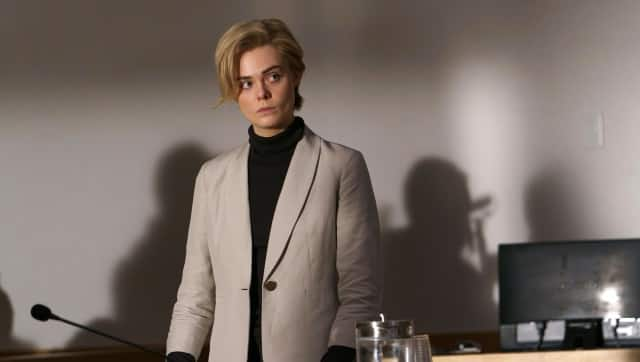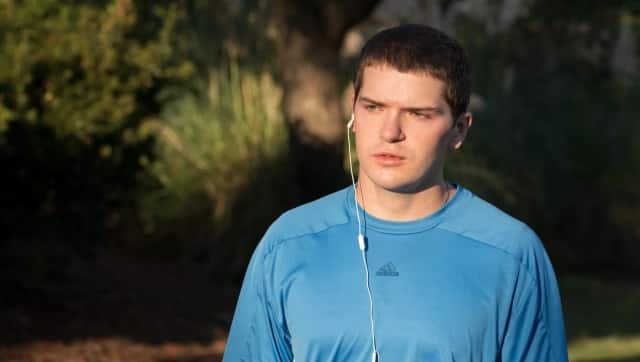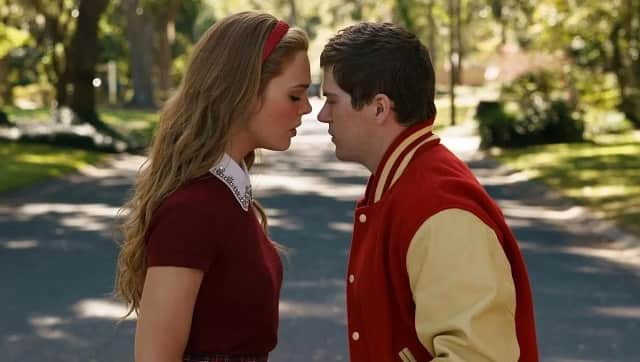Language: English At the end of the season premiere of The Girl from Plainville
, there is an off-putting scene which acts as a tidy summation of its true-crime story about delusional fantasies and fractured identities. The titular character Michelle Carter (
Elle Fanning
) is alone in her bedroom, watching herself in the mirror as she rehearses a eulogy she intends to give at the funeral of her boyfriend Conrad “Coco” Roy (Colton Ryan). “I loved him, and he loved me, and he loved all of you guys. I know he did,” she says, as tears flow down her cheek. Then, she turns around abruptly like she forgot a line, opens her laptop, and plays a scene from Glee where
Lea Michele
pays tribute to her boyfriend and co-star Cory Monteith, who had died from an accidental drug overdose. Carter, it turns out, is merely repeating word for word Michele’s tribute in a re-enactment of the scene from the popular TV show. Turning back towards the mirror again, she sings along with Michele a rendition of ‘Make You Feel My Love.’ In a spellbinding performance, Fanning leverages her malleable face to capture Carter’s practiced self-deception as the grieving girlfriend. Where Carter’s own performance began and ended and why did she encourage her boyfriend to die by suicide are questions that confound even the show’s creators Liz Hannah and Patrick Macmanus. For where self-deception resides, motivation hides Inspired by the 2014 “texting suicide case” that led to the trial and subsequent conviction of Carter on an involuntary manslaughter charge, The Girl from Plainville tells a story about a co-dependent relationship between two teenagers, each with a history of mental illness, that ultimately proved tragic. While the tabloids were quick to make their judgements, the miniseries takes its time to extend some nuance and some humanity to both Roy and Carter. Rather than resort to simplistic moralising, it examines the challenges of treating mental health and behavioural problems, and thus blossoms into something beyond a true-crime dramatisation. [caption id=“attachment_10826401” align=“alignnone” width=“640”] Elle Fanning as Michelle Carter[/caption] Without defending Carter’s actions, the show allows Fanning to quietly demonstrate the toll of a young woman struggling to socialise with others, battling body image issues and suffering from an eating disorder. Roy was a clinically depressed young man who had previously attempted suicide. Flashbacks show how the two met during a 2012 Florida vacation and instantly hit it off, bonding over their shared alienation. But the meeting feels like a ticking time bomb, as the text chains go from flirty to supportive to disturbing. The two forge an unhealthy relationship where they are both each other’s only source of validation. Ryan brings a real emotional heft to a young man who wants to be happy but can’t figure out how. His measured performance adds to the complexity and ambiguity of Fanning’s depiction of Carter. Though Carter and Roy lived only an hour’s drive from each other, the couple in fact didn’t meet too often in person. Most of their conversations and repeated declarations of love happened via text and the occasional call. To capture the illusion of their relationship in their heads, the show visualises their text chains as in-person conversations instead of on-screen. These conversations are sometimes framed with the couple positioned sitting face-to-face on opposing sides of the screen and sometimes adjacent to each other to highlight the distance that comes from chatting via text — and to suggest they might not always see eye to eye even if it feels that way. Phone conversations can minimise and even distort the truth of one’s circumstances. At the same time, reading them out loud without context, as the police and prosecutors did, only simplified the truth. The legal proceedings in itself are not quite as compelling as the character studies of Carter and Roy, but their significance is well established by lead prosecutor Katie Rayburn (
Aya Cash
), who knows the judgment could set a legal precedent for future cases of encouraged suicide. [caption id=“attachment_10826411” align=“alignnone” width=“640”]
Elle Fanning as Michelle Carter[/caption] Without defending Carter’s actions, the show allows Fanning to quietly demonstrate the toll of a young woman struggling to socialise with others, battling body image issues and suffering from an eating disorder. Roy was a clinically depressed young man who had previously attempted suicide. Flashbacks show how the two met during a 2012 Florida vacation and instantly hit it off, bonding over their shared alienation. But the meeting feels like a ticking time bomb, as the text chains go from flirty to supportive to disturbing. The two forge an unhealthy relationship where they are both each other’s only source of validation. Ryan brings a real emotional heft to a young man who wants to be happy but can’t figure out how. His measured performance adds to the complexity and ambiguity of Fanning’s depiction of Carter. Though Carter and Roy lived only an hour’s drive from each other, the couple in fact didn’t meet too often in person. Most of their conversations and repeated declarations of love happened via text and the occasional call. To capture the illusion of their relationship in their heads, the show visualises their text chains as in-person conversations instead of on-screen. These conversations are sometimes framed with the couple positioned sitting face-to-face on opposing sides of the screen and sometimes adjacent to each other to highlight the distance that comes from chatting via text — and to suggest they might not always see eye to eye even if it feels that way. Phone conversations can minimise and even distort the truth of one’s circumstances. At the same time, reading them out loud without context, as the police and prosecutors did, only simplified the truth. The legal proceedings in itself are not quite as compelling as the character studies of Carter and Roy, but their significance is well established by lead prosecutor Katie Rayburn (
Aya Cash
), who knows the judgment could set a legal precedent for future cases of encouraged suicide. [caption id=“attachment_10826411” align=“alignnone” width=“640”] Colton Ryan as Conrad Roy III[/caption] Reading the warning signs can often be just as difficult as treating depression. This is explored in the series through Roy’s relationship with his parents. In the wake of his first suicide attempt, he promises his mother Lynn (
Chloë Sevigny
) he won’t do it again. Once things go back to the routine, she is keen to believe she has got her son all the help he needs to pull round. But as the show reveals, what made his death all the more devastating was the same morning, she had taken him and his two sisters to the beach, and introduced him to guacamole. It shows just how the signs and symptoms can be masked by those suffering from it. As Lynn, Sevigny gives a heart-breaking portrait of a mother shattered by pain and guilt, but still trying to keep it together for her daughters. On Roy’s demise, we watch Carter, like a grief vampire, curry favour with Lynn, who appears oblivious to her son’s relationship with her. Carter’s own parents (
Cara Buono
and Kai Lennox) had no idea she was in a relationship with Roy. Yet, none of them object when she decides to arrange a charity baseball game in Roy’s honour to raise mental health awareness. But it becomes clear she is using the tragedy to earn brownie points and win the favour of high-school classmates Natalie (Ella Rubin) and Cassie (Kylie Liya Page). It’s in these moments we see the manipulative and needy sides to Carter. [caption id=“attachment_10826421” align=“alignnone” width=“640”]
Colton Ryan as Conrad Roy III[/caption] Reading the warning signs can often be just as difficult as treating depression. This is explored in the series through Roy’s relationship with his parents. In the wake of his first suicide attempt, he promises his mother Lynn (
Chloë Sevigny
) he won’t do it again. Once things go back to the routine, she is keen to believe she has got her son all the help he needs to pull round. But as the show reveals, what made his death all the more devastating was the same morning, she had taken him and his two sisters to the beach, and introduced him to guacamole. It shows just how the signs and symptoms can be masked by those suffering from it. As Lynn, Sevigny gives a heart-breaking portrait of a mother shattered by pain and guilt, but still trying to keep it together for her daughters. On Roy’s demise, we watch Carter, like a grief vampire, curry favour with Lynn, who appears oblivious to her son’s relationship with her. Carter’s own parents (
Cara Buono
and Kai Lennox) had no idea she was in a relationship with Roy. Yet, none of them object when she decides to arrange a charity baseball game in Roy’s honour to raise mental health awareness. But it becomes clear she is using the tragedy to earn brownie points and win the favour of high-school classmates Natalie (Ella Rubin) and Cassie (Kylie Liya Page). It’s in these moments we see the manipulative and needy sides to Carter. [caption id=“attachment_10826421” align=“alignnone” width=“640”] A still from The Girl from Plainville[/caption] For Carter, Glee provided a great escape from her everyday teenage reality. The show argues her fixation with the musical drama also disconnected her from reality to a point where she saw herself as Rachel to Roy’s Finn. This becomes an essential frame of reference for their relationship, as the show concretises her fantasies as Glee-like song-and-dance numbers. Alienated from friends and family for her role in Roy’s death, Carter is walking alone in her suburban neighbourhood, listening to Monteith’s cover of REO Speedwagon’s “Can’t Fight This Feeling,” when she and a resurrected Roy break into a musical routine, complete with costume changes, in the middle of an empty street. A musical daydream turns into a nightmare in a later scene, where Carter imagines her younger sister inviting her on stage to reprimand her for all the pain she’s caused in a choir-gone-wild performance of Wheatus’ “Teenage Dirtbag.” What cast the die and got Carter convicted in the end wasn’t Lynn Roy’s testimony or the texts. As the show illustrates in a chilling moment, a scared Roy got out of the truck he had filled with carbon monoxide fumes — before Carter urged him to get back inside and finish what he started. The overarching question is and still remains an unanswered why. Did she delude herself into thinking she was actually helping him? Did she hope it would garner her sympathy as the grieving girlfriend and reclaim the attention of former friends? Did her obsession with Glee leave her imagining this was just another tragic romance? There is some amount of truth to each version, and that’s what the showrunners settle on at the end. There is no clear answer. Yet, in a typical true-crime paradox, even if the show paints a more nuanced portrait of Carter and Roy’s relationship, our own understanding is still coloured by the thoughts, opinions and judgments of everyone but them. The Girl from Plainville will be available for streaming on Lionsgate Play from 24 June
A still from The Girl from Plainville[/caption] For Carter, Glee provided a great escape from her everyday teenage reality. The show argues her fixation with the musical drama also disconnected her from reality to a point where she saw herself as Rachel to Roy’s Finn. This becomes an essential frame of reference for their relationship, as the show concretises her fantasies as Glee-like song-and-dance numbers. Alienated from friends and family for her role in Roy’s death, Carter is walking alone in her suburban neighbourhood, listening to Monteith’s cover of REO Speedwagon’s “Can’t Fight This Feeling,” when she and a resurrected Roy break into a musical routine, complete with costume changes, in the middle of an empty street. A musical daydream turns into a nightmare in a later scene, where Carter imagines her younger sister inviting her on stage to reprimand her for all the pain she’s caused in a choir-gone-wild performance of Wheatus’ “Teenage Dirtbag.” What cast the die and got Carter convicted in the end wasn’t Lynn Roy’s testimony or the texts. As the show illustrates in a chilling moment, a scared Roy got out of the truck he had filled with carbon monoxide fumes — before Carter urged him to get back inside and finish what he started. The overarching question is and still remains an unanswered why. Did she delude herself into thinking she was actually helping him? Did she hope it would garner her sympathy as the grieving girlfriend and reclaim the attention of former friends? Did her obsession with Glee leave her imagining this was just another tragic romance? There is some amount of truth to each version, and that’s what the showrunners settle on at the end. There is no clear answer. Yet, in a typical true-crime paradox, even if the show paints a more nuanced portrait of Carter and Roy’s relationship, our own understanding is still coloured by the thoughts, opinions and judgments of everyone but them. The Girl from Plainville will be available for streaming on Lionsgate Play from 24 June
Prahlad Srihari is a film and music writer based in Bengaluru. Read all the Latest News _,_ Trending News _,_ Cricket News _,_ Bollywood News _,_ India News and Entertainment News here. Follow us on Facebook _,_ Twitter and Instagram _._
)